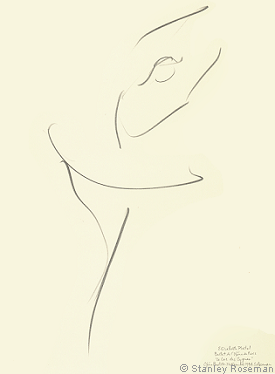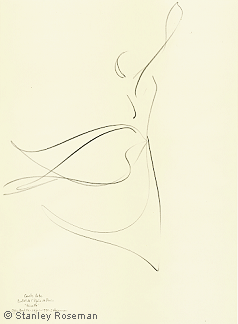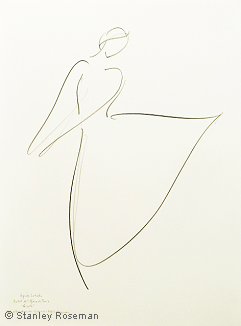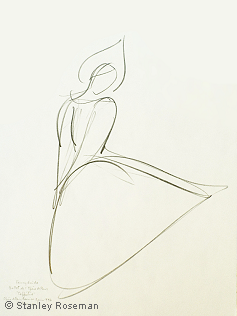

Elisabeth Platel, 1994
Paris Opéra Ballet
Swan Lake
Pencil on paper, 38 x 28 cm
Collection of the artist
Paris Opéra Ballet
Swan Lake
Pencil on paper, 38 x 28 cm
Collection of the artist
The Danseuse
STANLEY ROSEMAN
Drawings
Drawings

''Drawing has again become movement thanks to you, Stanley, discreet witness of our life on the stage. Thank you for your benevolent regard and bravo for your talent.''*
- Elisabeth Platel
Star Dancer of the Paris Opéra
Star Dancer of the Paris Opéra
The danseuse in leading roles in celebrated Romantic and classical ballets including La Sylphide, Giselle, Coppélia, Swan Lake, The Sleeping Beauty, and The Nutcracker is depicted in Roseman's drawings on the dance at the Paris Opéra. Heroines with familiar names as Juliet, Manon, Carmen, and Cinderella portrayed by ballerinas at the Paris Opéra also inspired Roseman in his drawings on the dance. The artist's drawings present the danseuse in stage personae such as an Indian temple dancer, a Greek goddess, a sacrificial maiden of a primitive tribal rite in ancient Russia, and as her own identity in choreographic works of modern dance.
"Dressed in black to blend into the shadows, Stanley Roseman stands in the wings of the Paris Opéra,
capturing the grace and virtuosity of France's top ballet dancers
with a few masterful strokes of a pencil.''
capturing the grace and virtuosity of France's top ballet dancers
with a few masterful strokes of a pencil.''
- Associated Press, Paris
Romantic Ballet
In a text to accompany his work at the Paris Opéra, Roseman writes: "Romantic ballet developed and was nurtured at the Paris Opéra from the second quarter of the nineteenth century. The role of the ballerina is central to Romantic ballet, which introduced the diaphanous, bell-shaped tutu of white muslin and emphasized the new technique of dancing en pointe in pale, pink tights and pink satin slippers with a reinforced toe. . . .
The Bibliothèque Nationale de France conserves Roseman's beautiful drawing Carole Arbo, 1995, (fig. 2). The artist has rendered with a fluency of pencil lines the ethereal femininity of the star dancer as Giselle, who seemingly floats across the spacial dimension of the paper, her head leaning back, her right arm raised high into the air.
2. Carole Arbo, 1995
Paris Opéra Ballet
Giselle
Pencil on paper, 38 x 28 cm
Bibliothèque Nationale de France,
Paris
Paris Opéra Ballet
Giselle
Pencil on paper, 38 x 28 cm
Bibliothèque Nationale de France,
Paris

"Giselle had its world-premiere in 1841 at the Paris Opéra. The noted poet and novelist Théophile Gautier, a champion of the Romantic Movement in the arts, wrote the haunting scenario based on Germanic folklore recounted by Heinriche Heine. The marvelous score for Giselle by Adolphe Adam employs an early use of leitmotifs in music to establish character and further the story. Giselle, a village girl who is deceived by the man she loves, dies in a state of delirium. One night she is summoned from her eternal sleep to dance in a moonlit forest inhabited by Wilis, nocturnal spirits of young girls having died before their wedding day.
"In the closing decade of the twentieth century, the Paris Opéra's production of Giselle was remounted and adapted by Ballet Masters Eugene Polyakov and Patrice Bart after the original choreography by Jean Coralli and Jules Perrot. My work at the Opéra provided me with the wonderful opportunity to draw at performances of this celebrated ballet that was created for the Paris Opéra some hundred and fifty years before.''
Presented at the top of the page is Roseman's splendid drawing Elisabeth Platel, 1994. The Paris Opéra star dancer premiered the role of Odette/Odile in Rudolf Nureyev's choreographic version of Swan Lake.
Swan Lake, Tchaikovsky's first ballet, had its world-premiere at the Bolshoi Theatre, Moscow, in 1877. This quintessential classical ballet tells the story of a young woman who is malevolently transformed into a swan but who harbors a love for her suitor, a handsome prince. Nureyev choreographed Swan Lake for the Paris Opéra Ballet in 1984. Nureyev's version, which retains the ambiance of the original choreography by Marius Petipa and Lev Ivanov and gives a contemporary interpretation in the character development, has become the standard production of the ballet in the repertory of the Paris Opéra.
Roseman created an impressive composition in the drawing of Elisabeth Platel in Swan Lake. The diagonal placement of the figure on the page and the economy of fluent, pencil lines accentuate the sense of movement. A sweeping, curvilinear stroke of the pencil defines the tutu that symbolizes the female attire in classical ballet.
3. Agnès Letestu, 1998
Paris Opéra Ballet
Giselle
Pencil on paper, 38 x 28 cm
Collection of the artist
Paris Opéra Ballet
Giselle
Pencil on paper, 38 x 28 cm
Collection of the artist
The role of Myrtha is traditionally portrayed by a star dancer or premier dancer. Roseman's drawings from performances of Giselle over several seasons at the Paris Opéra include drawings of Agnès Letestu, who was nominated étoile in 1997. Roseman notes in his journal:
"Agnès was a premier dancer when I drew her as Myrtha in Giselle in 1993. I was very happy to have the opportunity to draw her again as a star dancer in the role at performances of the ballet in 1998.''
Act Two of Giselle is set in a moonlit, forest glade. Myrtha, Queen of the Wilis, makes a regal entrance dancing on point and evokes the spirits of the deceased maidens in her charge. Adolphe Adam composed a hauntingly lyrical passage for the variation, or solo, of Myrtha that establishes her dominant character and importance to the story.
Roseman's suite of drawings of Agnès Letestu as the Queen of the Wilis includes a depiction of the ballerina in three-quarter profile, with her right arm raised high in a commanding gesture, and a drawing of her with arms crossed over her chest. Presented here is the eloquent drawing Agnès Letestu, 1998, (fig. 3).
With an economy of curvilinear strokes of the pencil, Roseman expresses an ethereal quality of the danseuse. Fluent lines describe the prima ballerina in an arabesque position, with a graceful turn of her head and her arms outstretched in front of her. A single, curved line extends from her hair, tied in a bun, to her forehead, with an accented, short, pencil stroke indicating the tiara worn by Myrtha and establishing her regal identity in this quintessential Romantic ballet.
© Stanley Roseman and Ronald Davis - All Rights Reserved
Visual imagery and website content may not be reproduced in any form whatsoever.
Visual imagery and website content may not be reproduced in any form whatsoever.
This page will present a further selection of Roseman's drawings of the danseuse: Sylvie Guillem in La Bayadère; Delphine Moussin in Rhapsody; Clairemarie Osta in Don Quichotte; Claude de Vulpian in Dances at a Gathering; and Takako Asakawa in Herodiade from the Martha Graham Dance Company's guest appearance at the Paris Opéra in 1991.
Please return again.
Please return again.
* Stanley Roseman - Dessins sur la Danse à l'Opéra de Paris, (Paris, Bibliothèque Nationale de France, 1996), p. 13.
1. John Warrack, Tchaikovsky, (London: Hamish Hamilton Ltd, 1989). p. 92, 93.
2. Stanley Roseman - Dessins sur la Danse à l'Opéra de Paris, p. 12.
1. John Warrack, Tchaikovsky, (London: Hamish Hamilton Ltd, 1989). p. 92, 93.
2. Stanley Roseman - Dessins sur la Danse à l'Opéra de Paris, p. 12.
Page 3 - The Danseuse

"Stanley Roseman's drawings show the many facets of his great talents as a draughtsman.''[2]
- Bibliothèque Nationale de France, Paris
4. Fanny Gaïda, 1996
Paris Opéra Ballet
Coppélia
Pencil on paper, 38 x 28 cm
Private collection, Pennsylvania
Paris Opéra Ballet
Coppélia
Pencil on paper, 38 x 28 cm
Private collection, Pennsylvania

Coppélia was the third of three celebrated Romantic ballets that had their world premieres at the Paris Opéra: La Sylphide, 1832; Giselle, 1841, as noted above; and Coppélia, 1870. Roseman writes in his text on drawing at the Paris Opéra: "As with La Sylphide and Giselle, Coppélia also premiered at the former Paris Opéra located on rue Le Peletier. Coppélia, based on the fantastic tale Der Sandmann by E.T.A. Hoffmann, was choreographed by Arthur Saint-Léon to the music of Léo Delibes, whose symphonic ballet score influenced a following generation of composers, including Tchaikovsky, who acknowledged his debt to the French composer.[1]
"During the third quarter of the nineteenth century, construction was under way on the present Paris Opéra, commissioned by Napoleon III and begun in 1862. The Nouvel Opéra, as it was then referred to, or the Palais Garnier, after the architect Charles Garnier, was completed and inaugurated under the Third Republic in 1875.
"In 1996, for the gala reopening of the Palais Garnier following a year and a half of renovation, the Paris Opéra Ballet presented the premiere of a contemporary rendition of Coppélia choreographed by Patrice Bart, respected Ballet Master of the Paris Opéra Ballet. I had the great pleasure of drawing on opening night and at subsequent performances of Coppélia with an excellent ensemble dancing to the wonderful melodies of Delibes.
"Star dancer Fanny Gaïda premiered the role of Swanilda, a pretty, Central-European country girl who impersonates an automated doll in the laboratory of Dr. Coppélius. The eccentric inventor's infatuation for Swanilda is thwarted by a young rival named Frantz, equally in love with the charming maiden with whom he is reunited in the ballet's final scene.''
Roseman has expressed the charming quality of Swanilda wonderfully portrayed by Fanny Gaïda and seen in the beautiful drawing presented here, (fig. 4). The danseuse wears a bell-shaped tutu that identifies Romantic ballet. Fluent curvilinear lines are a distinguishing element in Roseman's drawings. Here the pencil lines describe the danseuse gracefully turning to the right, her head inclined, arms lowered, and taking an arabesque position, a favored and essential dance movement in ballet. The danseuse's headdress, rendered with two curved lines, adds a crowning, feminine touch to a lovely image of the prima ballerina.
Coppélia was one of several ballets performed at the Paris Opéra during the exhibition Stanley Roseman - Dessins sur la Danse a l'Opéra de Paris (March 12 - June 9, 1996) presented by the Bibliothèque Nationale de France in its library and museum the Bibliothèque-Musée de l'Opéra housed in the Palais Garnier.